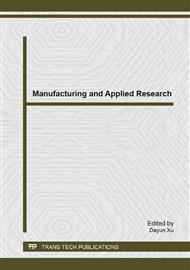[1]
Z. Wang, &N. Wang, Knowledge sharing, innovation and firm performance. Expert System with Application. 39 (2012), 8899–8908.
DOI: 10.1016/j.eswa.2012.02.017
Google Scholar
[2]
R.S. Alwis&E. Hartmann, The use of tacit knowledge within innovative companies: knowledge management in innovative enterprises. Journal of Knowledge Management, 12 (1)(2008), 33-147.
DOI: 10.1108/13673270810852449
Google Scholar
[3]
E. Miron, M. Erez, and E. Naveh, Do personal characteristics and cultural values that promote innovation, quality, and efficiency compete or complement each other?, Journal of Organizational Behaviour, 25(2004), 175-199.
DOI: 10.1002/job.237
Google Scholar
[4]
C.B. Dobni, Measuring innovation culture in organizations: The development of a generalized innovation culture construct using exploratory factor analysis. European Journal of Innovation, 11 (4) (2008), 539-559.
DOI: 10.1108/14601060810911156
Google Scholar
[5]
G. Krogh, Individualist and collectivist perspectives on knowledge in organizations: Implications for information systems research. Journal of Strategic InformationSystem, 18(3)(2009), 119-129.
DOI: 10.1016/j.jsis.2009.08.001
Google Scholar
[6]
F.H. Wang, Knowledge Management. China: Economy Shan Xi Publisher. (1999).
Google Scholar
[7]
J.C.R. Vazquez,V. Lillian ,O. Fournier, &F.R. Flores, Overcoming cultural barriers for innovation and knowledge sharing. Journal of Knowledge Management, 13 (5)(2009) , 257–270.
DOI: 10.1108/13673270910988097
Google Scholar
[8]
W.B. Lin, The exploration factors of affecting knowledge sharing: The case of Taiwan's high-tech industry. Expert System with Application, 35(2008), 661-676.
DOI: 10.1016/j.eswa.2007.07.038
Google Scholar
[9]
M. Myers, and M. Cheung, Sharing global supply chain knowledge. MIT SloanManagement Review, 49 (4)(2008), 67-73.
Google Scholar
[10]
C. Lin, To share or not to share: Modeling tacit knowledge sharing, its mediators and antecedents. Journal of Business Ethics, 70(2007), 411-428.
DOI: 10.1007/s10551-006-9119-0
Google Scholar
[11]
W. Tsai, andS. Ghoshal, Social Capital and Value Creation: The Role of Intrafirm Networks. The Academy of Management Journal , 41 (4 )(1998), 464-476.
DOI: 10.5465/257085
Google Scholar
[12]
S. A, Harkema, complex adaptive perspective on learning within innovation projects. The Learning Organization, 10 (6)(2003), 340-346.
DOI: 10.1108/09696470310497177
Google Scholar
[13]
L.B. Cardinal, T.M. Allessandri and S.F. Turner, Knowledge codifiability, resources and Sciencesbased innovation. Journal of knowledge Management, 5 (2)(2001), 195-204.
DOI: 10.1108/13673270110393266
Google Scholar
[14]
E. Maravelakis, N. Bilalis, A. Antoniadis, K.A. Jones, and V. Moustakis, Measuring and benchmarking the innovativeness of SMEs: a three-dimensional fuzzy logic approach. Production Planning & Control, 17 (3)(2006), 283-292.
DOI: 10.1080/09537280500285532
Google Scholar
[15]
W.M. Cohen, and D.A. Levinthal, Absorptive capacity: a new perspective on learning and innovation. Administrative Science Quarterly, 35 (1)(1990), 128-152.
DOI: 10.2307/2393553
Google Scholar
[16]
R.J. Calantone, S.T. Cavusgil and Y. Zhao, Learning oreientation, firm innovation capability, and firm performance. Industrial Marketing Management, 31 (6)(2002), 515-524.
DOI: 10.1016/s0019-8501(01)00203-6
Google Scholar
[17]
A. Hargadon, and R. Sutton, Technology brokering and innovation in a product development firm. Administrative Science Quarterly, 42(4)(1997), 716-749.
DOI: 10.2307/2393655
Google Scholar
[18]
J.P.J. Jong, andD.N. Hartog, How leaders influence employees' innovative behaviour. European Journal of Innovation Management, 10 (10)(2007), 41-64.
DOI: 10.1108/14601060710720546
Google Scholar
[19]
L.J. Gressgard, Virtual team collaboration and innovation in organizations. Team Performance Management, 17 (1/2)(2011), 102-119.
DOI: 10.1108/13527591111114738
Google Scholar
[20]
P. Niu, F. Xie and T. Leonard, Empirical study of the relations between the knowledge base and innovation performance of an economy. Journal of Knowledge Base Innovation in China, 2 (2)(2010), 171-185.
DOI: 10.1108/17561411011054805
Google Scholar
[21]
J. Yang, Innovation capability and corporate growth: An empirical investigation in China. Journal of engineering and Technology Management, 29(2012), 34-46.
DOI: 10.1016/j.jengtecman.2011.09.004
Google Scholar
[22]
K. Tsai, C. Chou andM.Y. Chen, Does matching pay policy with innovation strategy really improve firm performance?. Personal Review, 37 (3)(2008), 300-316.
DOI: 10.1108/00483480810862288
Google Scholar
[23]
L. Prusak, Where did knowledge management come from? IBM Systems Journal, 40(4)(2001), 1002.
DOI: 10.1147/sj.404.01002
Google Scholar
[24]
A.I. Al-Alawi, N.Y. Al-Marzooqi, and Y.F. Mohammed, Organizationalculture and knowledge sharing: Critical success factors. Journal of Knowledge Management, 11 (2)(2007), 22-42.
DOI: 10.1108/13673270710738898
Google Scholar
[25]
D. Brachos, K. Kostopoulos, K.E. Sonderquist andG. Prastacos, Knowledgeeffectiveness, social context and innovation. Journal of Knowledge Management, 11 (5)(2007), 31-44.
DOI: 10.1108/13673270710819780
Google Scholar
[26]
M. Sandhu, K. Jain, and I. Ahmad, Knowledge sharing among public sector employees: Evidence from Malaysia. International Journal of Public SectorManagement, 24(2011) , 206–226.
DOI: 10.1108/09513551111121347
Google Scholar
[27]
J. Yang, The impact of knowledge sharing on organizational learning and effectiveness. Journal of Knowledge Management, 11 (2)(2007), 83-90.
DOI: 10.1108/13673270710738933
Google Scholar


